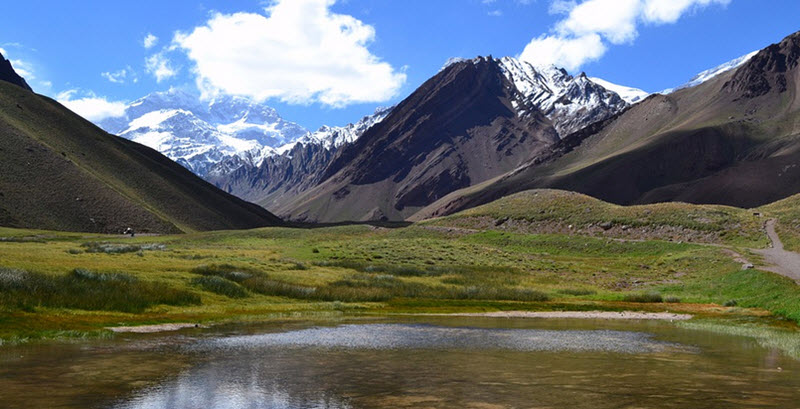With a summit elevation of 6,961 meters (22,838 feet), Aconcagua is the tallest mountain not just in Argentina but in all of the Americas. It is a part of the Principal Cordillera, the Andean mountain range that forms the boundary between Central Chile and neighbouring areas of Argentina. Aconcagua is located completely within Argentina, but not far from the Chilean border.

The Aconcagua was a sacred mountain to the Incas, who had places for worship and sacrifices here. In 1985, one such site was discovered at 5,167 meters above sea level, making it one of the highest places of worship in the world. It is considered the most difficult to reach of all the known Inca sites. One of the more notable findings from this place is the Aconcagua mummy; the remains of a seven-year-old boy found preserved inside a stone structure, sitting on a bed of grass, cloth and feathers, and wearing expensive clothes. The mummy has been dated to circa 1500 AD.
Why the mountain is named Aconcagua remains unclear. It is possible that it comes from the Mapudungun ”Aconca-Hue” which means ”comes from the other side” and is the Mapudungun name for the Aconcagua River. Other suggestions are ”Ackon Cahuak” or ”Ancon Cahuac” which means Sentinel of Stone and White Sentinel, respectively, in Quechua. In Aymara, ”Janq´u Q´awa” means White Ravine.
Short facts about Aconcagua
Coordinates: 32°39′11.51″S 070°0′40.32″W
Elevation: 6,960.8 metres
Prominence: 6,960.8 metres
Isolation: 16,533.4 km
Parent range: Cordillera Principal in the Andes
Largest glacier: Ventisquero Horcones Inferior
Geological history
Aconcagua was created by the subduction of the Nazca Plate beneath the South American Plate. Aconcagua used to be an active stratovolcano and consisted of several volcanic complexes. It is not an active volcano today, because thrust faults has lifted Aconcagua up off its volcanic root.
Nautilus
An art gallery tent with contemporary art by Argentine painter Miguel Doura is located in the base camp Plaza de Mulas, at an elevation of 4,300 metres. It is the highest contemporary art gallery tent in the world.
Aconcagua Provincial Park
The mountain and its surroundings are a part of the Aconcagua Provincial Park.
Climbing the Aconcagua
As mentioned above, the Aconcagua was sacred to the Incas, who used it for worship and ritual sacrifices. The highest found Inca place of worship on this mountain was discovered at an elevation of 5,167 meters. (The summit is at 6,961 meters).
The first known attempt to summit by a European did not take place until 1883, when the German geologist Paul Düsseldorf led a party up to circa 6,500 meters. To entice porters to take part, he had told them a story of a treasure on the mountain. This expedition used the Rio Volcan route and made two attempts on the peak by the north-west ridge.
The first recorded European summit took place in 1897. The expedition´s leader Edward FitzGeral, a British mountaineer, failed to reach the peak (despite making eight attempts in December 1896 – February 1897), but the Swiss guide Matthias Zurbriggen reached the summit on 14 January 1897. A month later, Stuart Vines and Nicola Lanti also reached the summit.
Various modern-day records
- In 2013, nine-year-old Tyler Armstrong from the United States became the youngest person to reach the summit of Aconcagua.
- The record for oldest person to summit Aconcagua is held by Scott Lewis, who was 87 years old when he did it in 2007.
- In 2019, an Airbus Helicopters H145 landed on the peak. It was the first time a twin-engine helicopter landed at such an altitude. (A single-engine helicopter has landed at a higher elevation on Mount Everest.)
